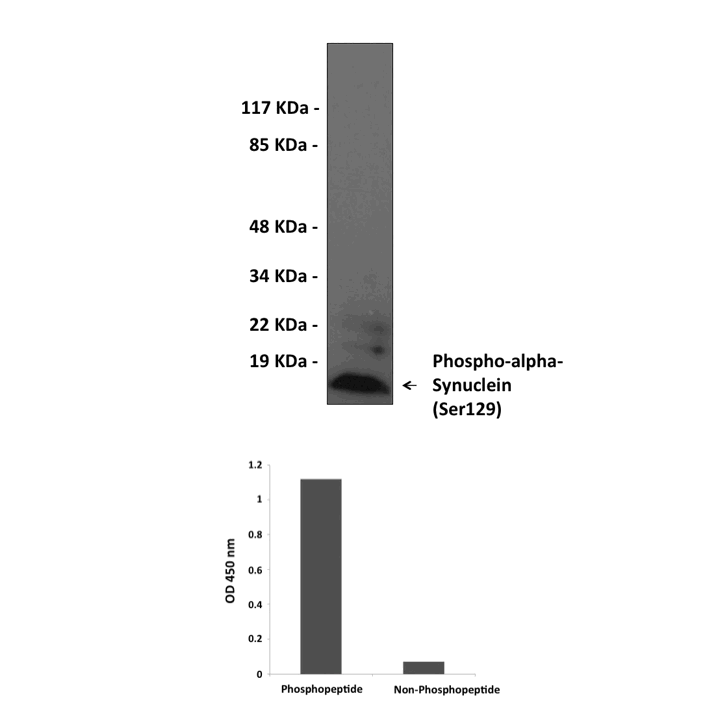Product Sheet CG1656
Description
BACKGROUND Synucleins are small, soluble proteins expressed primarily in neural tissue and in certain tumors. The family includes three known proteins: alpha-Synuclein, beta-Synuclein, and gamma-Synuclein.1 All Synucleins have in common a highly conserved alpha-helical lipid-binding motif with similarity to the class-A2 lipid-binding domains of the exchangeable apolipoproteins. Synuclein family members are not found outside vertebrates, although they have some conserved structural similarity with plant ‘late-embryo-abundant proteins. The alpha- and beta-Synuclein proteins are found primarily in brain tissue, where they are seen mainly in presynaptic terminals. The gamma-Synuclein protein is found primarily in the peripheral nervous system and retina, but its expression in breast tumors is a marker for tumor progression.2 Normal cellular functions have not been determined for any of the Synuclein proteins, although some data suggest a role in the regulation of membrane stability and/or turnover.3 Mutations in alpha-Synuclein are associated with rare familial cases of early-onset Parkinson’s disease, and the protein accumulates abnormally in Parkinson’s disease, Alzheimer’s disease, and several other neurodegenerative illnesses.4 Phosphorylation of alpha-Synuclein at Ser 129 promoted fibril formation in vitro and these results highlight the importance of phosphorylation of filamentous proteins in the pathogenesis of neurodegenerative disorders.5
REFERENCES
1. George, J.M.: Genome Biol. 3:3002.1-6, 2001
2. Maries, E. et al: Nature Rev. Neurosci. 4:727-38, 2003
3. Galvin, J.E. et al: Arch. Neurol. 58:186-190, 2001
4. Lucking, C.B. & Brice, A.:Cell. Mol. Life Sci. 57:1894-1908,2000
5. Fujiwara, H. et al: Nature Cell Biol. 4:160-4, 2002
2. Maries, E. et al: Nature Rev. Neurosci. 4:727-38, 2003
3. Galvin, J.E. et al: Arch. Neurol. 58:186-190, 2001
4. Lucking, C.B. & Brice, A.:Cell. Mol. Life Sci. 57:1894-1908,2000
5. Fujiwara, H. et al: Nature Cell Biol. 4:160-4, 2002
Products are for research use only. They are not intended for human, animal, or diagnostic applications.
Details
Cat.No.: | CG1656 |
Antigen: | Range AA114 to 140 |
Isotype: | Rabbit IgG |
Species & predicted species cross- reactivity ( ): | Human, Mouse, Rat |
Applications & Suggested starting dilutions:* | WB 1:500-1:1000 IP n/d IHC n/d ICC n/d FACS n/d ELISA 1:1000 |
Predicted Molecular Weight of protein: | 14 kDa |
Specificity/Sensitivity: | Detects endogenous phosphorylated alpha-Synuclein (Ser129) proteins without cross- reactivity with other family members. |
Storage: | Store at -20°C, 4°C for frequent use. Avoid repeated freeze-thaw cycles. |
*Optimal working dilutions must be determined by end user.
Products
| Product | Size | CAT.# | Price | Quantity |
|---|---|---|---|---|
| Rabbit Alpha-Synuclein, Phospho-Ser129 Antibody: Rabbit alpha-Synuclein, Phospho-Ser129 Antibody | Size: 100 ul | CAT.#: CG1656 | Price: $384.00 |
Resources/Documents
Publications
2015
Cairns, N., R. Perrin, E. Franklin, D. Carter, B. Vincent, M. Xie, R. Bateman, T. Benzinger, K. Friedrichsen, W. Brooks, G. Halliday, C. McLean, B. Ghitti and J. Morris. Neuropathologic assessment of participants in two multi-center longitudinal observational studies: the Alzheimer Disease Neuroimaging Initiative (ADNI) and the Dominantly Inherited Alzheimer Network (DIAN). J Japanese Soc Neuropath 35:390–400.
Franklin, E., R. Perrin, B. Vincent, M. Baxter, J. Morris, and N. Cairns. 2015. Brain collection, standardized neuropathologic assessment, and comorbidity in Alzheimer's Disease Neuroimaging Initiative 2 participants. Alzheimer’s & Dementia, 11:815-822.

